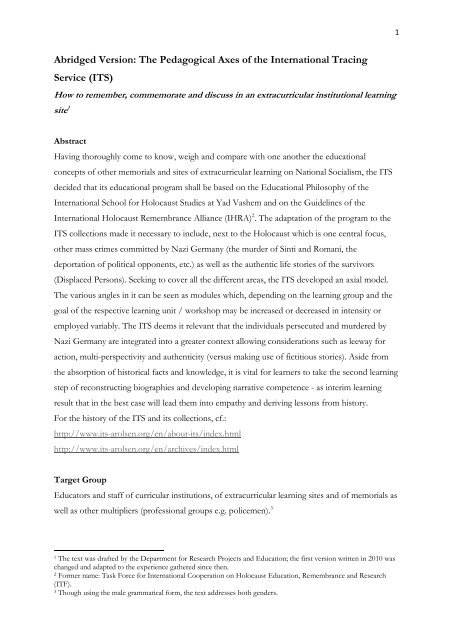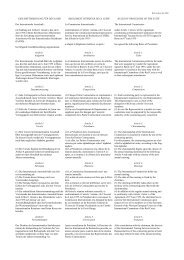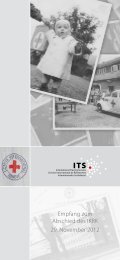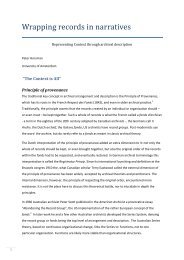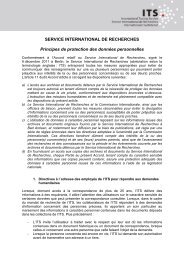Download Pedagogical Axes (pdf 132 KB) - International Tracing ...
Download Pedagogical Axes (pdf 132 KB) - International Tracing ...
Download Pedagogical Axes (pdf 132 KB) - International Tracing ...
You also want an ePaper? Increase the reach of your titles
YUMPU automatically turns print PDFs into web optimized ePapers that Google loves.
Abridged Version: The <strong>Pedagogical</strong> <strong>Axes</strong> of the <strong>International</strong> <strong>Tracing</strong><br />
Service (ITS)<br />
How to remember, commemorate and discuss in an extracurricular institutional learning<br />
site 1<br />
Abstract<br />
Having thoroughly come to know, weigh and compare with one another the educational<br />
concepts of other memorials and sites of extracurricular learning on National Socialism, the ITS<br />
decided that its educational program shall be based on the Educational Philosophy of the<br />
<strong>International</strong> School for Holocaust Studies at Yad Vashem and on the Guidelines of the<br />
<strong>International</strong> Holocaust Remembrance Alliance (IHRA) 2 . The adaptation of the program to the<br />
ITS collections made it necessary to include, next to the Holocaust which is one central focus,<br />
other mass crimes committed by Nazi Germany (the murder of Sinti and Romani, the<br />
deportation of political opponents, etc.) as well as the authentic life stories of the survivors<br />
(Displaced Persons). Seeking to cover all the different areas, the ITS developed an axial model.<br />
The various angles in it can be seen as modules which, depending on the learning group and the<br />
goal of the respective learning unit / workshop may be increased or decreased in intensity or<br />
employed variably. The ITS deems it relevant that the individuals persecuted and murdered by<br />
Nazi Germany are integrated into a greater context allowing considerations such as leeway for<br />
action, multi-perspectivity and authenticity (versus making use of fictitious stories). Aside from<br />
the absorption of historical facts and knowledge, it is vital for learners to take the second learning<br />
step of reconstructing biographies and developing narrative competence - as interim learning<br />
result that in the best case will lead them into empathy and deriving lessons from history.<br />
For the history of the ITS and its collections, cf.:<br />
http://www.its-arolsen.org/en/about-its/index.html<br />
http://www.its-arolsen.org/en/archives/index.html<br />
Target Group<br />
Educators and staff of curricular institutions, of extracurricular learning sites and of memorials as<br />
well as other multipliers (professional groups e.g. policemen). 3<br />
1 The text was drafted by the Department for Research Projects and Education; the first version written in 2010 was<br />
changed and adapted to the experience gathered since then.<br />
2 Former name: Task Force for <strong>International</strong> Cooperation on Holocaust Education, Remembrance and Research<br />
(ITF).<br />
3 Though using the male grammatical form, the text addresses both genders.<br />
1
<strong>Pedagogical</strong> Centrelines<br />
Centreline 1: The victims of National Socialism were not born as victims:<br />
Who is the subject of our educational narrative?<br />
Unlike historiography, pedagogy brings the individual human being to the fore of its activities.<br />
Though far from cutting out the historical background while focusing on individual stories, we<br />
take the stance that the meaning of single events can neither be grasped nor be taught if learning<br />
primarily centres on numbers, statistics and chronology.<br />
The historical ITS documents cast light on the circumstances of people’s persecution and death,<br />
or survival. The survivors themselves have made their voices heard and rendered an account of<br />
their own or their next-of-kin’s persecution in the DP documents and in the case<br />
correspondence files. The central significance these files have is owed to their diametrical<br />
opposition to Nazi ideology which took every effort to dehumanise people: they do abstain from<br />
tying people to their victims’ roles and show, and teach their readers to conceive, them to be<br />
individual human beings.<br />
Centreline 2: Stories of and on Human Beings: Perpetrators and Bystanders<br />
Though primarily directing its attention to the victims, the ITS does not fail to realise that a huge<br />
part of its files owes its creation to the existence of perpetrators and most various actors backing,<br />
taking part in and profiting by the Nazi system. And in fact it was people holding diverse<br />
positions and attending varied functions who victimised other people, humiliated them, exploited<br />
their work capacity, appropriated their belongings and murdered them. It is essential not to<br />
portray all the decision-makers and other actors responsible for the Nazi crimes as a lot of<br />
monsters or sadists. De facto they were ordinary men and women coming from all social classes.<br />
As perpetrators they managed to wholly dissociate themselves from their victims and to create a<br />
distance in the light of which they saw them as mere objects or material of either no value at all<br />
or use only for labour. Caused by stereotype opinion and manifest prejudice, that distance forced<br />
the perpetrator to cut out the “other person” from his/her view of man. And this capability of<br />
“banning the other one” enabled him/her to act as ruthlessly and efficaciously as the National<br />
Socialist ideology expected him/her to. An educational assessment of historical events that pays<br />
to this circumstance the attention it deserves will not generalize from a faceless, anonymous mass<br />
of Nazi victims, but, as a counterpoint, focus on and derive pedagogic use from individual life<br />
stories.<br />
2
Centreline 3: Options to act / Actors: Helpers and Rescuers<br />
Despite the moral failure of the civil society of the “Deutsche Reich” and most civil societies in<br />
other European countries, individuals or people who were integrated into networks able and<br />
willing to rescue or help, tried to stand by the persecuted people, be it by backing resistance<br />
activities or procuring forged identity papers, be it by offering people who had fled a hiding<br />
place, or food, be it by behaving humanely towards e.g. forced labourers. The help and assistance<br />
given – also within the victims’ groups themselves – are of utmost relevance from an educational<br />
standpoint because they show: all these helpers and rescuers assumed full responsibility for their<br />
deeds and, in general, were aware of their consequences.<br />
Learning groups working on the helpers’ and rescuers’ aspect should be sensitized to the<br />
problem and taught to consciously reflect on and question their thoughts and deeds, to check<br />
themselves for prejudice and to conceive themselves to be individuals of their own right and as<br />
such able to take decisions and be responsible for others.<br />
Centreline 4.1.: The Allies: Pragmatism and Welfare – Repatriation and Emigration<br />
The role the Allies had as liberators and helpers of millions of Displaced Persons (DPs), who had<br />
survived the Nazi terror in Germany and Europe, offers educators the opportunity to impart<br />
historical background knowledge from quite a different perspective. Action the Allies took as<br />
responsible bodies in the decision situations they faced at the time bore, in many a respect, the<br />
distinct marks of the social structure prevalent in their countries of origin. By helping the<br />
survivors to establish and organize a political structure in the DP Camps, the Western Allies did<br />
more than merely offering them a safe, an un-endangered life, giving them shelter, food and<br />
clothes. Acting in accordance with the typical Western life pattern, they gave them the extra of<br />
individual liberty and allowed them to have a free press, to elect a sort of camp parliament, to go<br />
to the theatre and the cinema and to frequent libraries. By contrast to the Western Allies, the<br />
Soviet Union refused to recognize the DPs’ specific political status; accordingly the country<br />
limited social DP activities in its occupation zone to fast repatriation action.<br />
Contextual discussions may be held on questions like: How do the files reflect the relatively<br />
restrictive immigration policy the US or the UK pursued concerning the DPs in particular<br />
consideration of the political climate prior to the creation of the state of Israel? Where do traces<br />
of welfare and moral assistance become visible? Studying the DPs’ files may advance novices in<br />
self-reliant, multi-lingual, multi-perspective learning.<br />
Centreline 4.2.: Displaced Persons: A New Beginning<br />
The impressive individual life stories of millions of DPs give us nowadays a telling account and<br />
3
example of the pains they took in the midst of destroyed Europe to seek and find their way back<br />
to their homelands, or of their persistent waiting for the chance to leave Europe for starting life<br />
afresh in Israel, the US, Canada, Australia or other countries. The variety of biographies we have<br />
for millions of DPs is of considerable educational value for exploratory learning. In view of the<br />
losses, traumata and humiliation the survivors of the Holocaust, of Nazi persecution and forced<br />
labour had suffered, the path they took was amazing: somehow gathering enough courage and<br />
will to live, they shaped their new beginning, often got married while still in the DP Camps, had<br />
children and thus laid the foundation for their new lives. They resumed the professions or jobs<br />
they had taken up before persecution or had retraining, they started new careers, they attended<br />
schools and universities, they committed themselves to playing roles on the social, political and<br />
cultural planes and thus contributed in many respects to a global restructuring after National<br />
Socialism and the Second World War. And what is more: the fates of the survivors and their<br />
return home or emigration give clear evidence on two historical facts: the aftermath of the Nazi<br />
crimes affected the world as a whole and the memory of its repercussions put down roots in the<br />
families in many states throughout the world.<br />
Centreline 5: Passing on the People’s Stories as Secondary Witnesses<br />
Autobiographies, reports written and published by the media and the legacy of the survivors of<br />
Nazi persecution and forced labour brought out on the occasion of anniversaries or meetings<br />
time and again remind us of the survivors’ wish that the wrong done to them and their murdered<br />
contemporaries shall not be forgotten and that the memory of the things that had happened to<br />
the narrators shall be carried and passed on.<br />
Dealing with individual fates and using the ITS documents to establish a connection with the<br />
statements made by the survivors themselves and their supplementation by video and audio<br />
testimonies from other archives and institutions, learners will develop a sense of responsibility<br />
for these life stories and experiences that will turn them into secondary witnesses of the stories at<br />
last.<br />
If you have any queries, please contact: historical-research@its-arolsen.org<br />
ITS, Department for Research Projects and Education, Bad Arolsen, January 2013<br />
4


